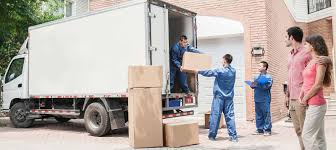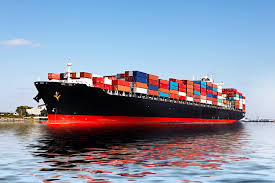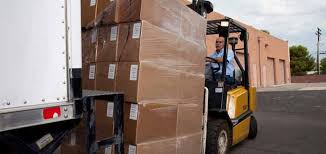Unloading With No Dock – Crane Vans and Trucks
STUFF, STRIP, UNLOAD, LOAD CONTAINERS — ALL WITHOUT A DOCK
So you need to stuff or strip a container, but you don’t have access to a loading dock. What are your options? There are lots of different equipment options and processes that can help you get the job done.
How you go about procuring the right equipment depends on your operation and budget. Buying and maintaining your own equipment may make sense if you’ve got an established operation with regular container throughput. But if you’re running a shorter term project or have capital constraints, renting the equipment, or paying a contractor to supply a container handling service, may be right for you.
From an operating standpoint, you have two general options for loading and unloading containers without a dock:
OPTION #1 – KEEP THE CONTAINER ON THE CHASSIS
- Lift the cargo between the ground and the container
- Use a mobile yard ramp
OPTION #2 – PLACE THE CONTAINER ON GROUND
- Use a crane
- Use a heavy forklift, reach stacker or mini straddle
- Use a swing lift or side loader
- Use a vertical container lift or C-Lift
- Use a fixed C-Lift in place of a dock

Using forklifts to unload straight trucks and semi trailers
One of the most dangerous operations involving forklifts is the loading and unloading of trucks and trailers. The reason is the change from the stable floor of the loading dock to the unstable deck of the truck or trailer. Not only may the vehicle being driven into be unstable, but the dockplate itself can be a hazard.
Have your employees perform the following before unloading:
Set the brakes
Make sure that the brakes are set on the vehicle to be unloaded. This could range from air brakes or spring-loaded brakes on semi-trailers to hand brakes on other vehicles.
Secure the vehicle
Secure the vehicle to the loading dock by using a mechanical dock locking system, if available. It may also be a good idea to use wheel chocks, even though OSHA no longer requires them. By securing the trailer, it is prevented from moving away from the loading dock when the forklift enters and leaves it.
Install the dockboard or plate
Install the dockboard or plate, and check it to make sure that it overlaps the truck or trailer floor and loading dock sufficiently to be secure, and that it is square with the loading area.
Check the condition of the trailer floor
The operator should inspect the floor of the truck or trailer to make sure that it is safe. Check for any weak, rotten or otherwise unsafe areas. If any are found, the forklift should not be driven onto it. Instead, a pallet jack may have to be used to load or unload these vehicles.
Make sure the nose of the trailer is supported
If the tractor has been removed from the trailer, the nose of the trailer must be supported by placing nose cones or jackstands to prevent the trailer from upending.
Check the lighting
Check the lighting in the trailer to see if there is adequate lighting for the job. If lighting is poor, turn on the trailer lights or use supplemental lighting.

The Safest Way to Unload Your Truck
Truckers are most prone to musculoskeletal injuries while loading and unloading their truck; this is due to the strain that bending, lifting, and heavy items put on the body. Sprains, hernias, and even fractures can occur due to improper body mechanics. Other accidents can occur in and around the truck to bystanders and workers. Securing both the truck and the unloading area is crucial for safety reasons. Here are several ways you can improve your working body form and safely unload your truck each time:
- Before unloading, perform a load risk assessment using your judgment. Check for items that aren’t secured or may be broken. Look for spillage or hazardous materials. Ensure the truck is parked in a safe place, and that you aren’t unloading in inclement weather.
- Ensure the truck is on a level surface, parked, with the engine off. Keys should be out of the ignition.
- Don your personal protective equipment, if necessary. These may include gloves, helmets, UV glasses, high visibility garments, wrist guards, steel-toed boots, long-sleeved shirts and pants, earplugs, and sunscreen.
- Restrict personnel on foot from the loading zone to prevent accidents and confusion.
- Ensure appropriate forklift and machinery equipment licensing and experience.

How Many Pallets Fit in a Truck?
“2 standard-sized pallets can fit side by side in the truck”
When it comes to LTL shipping, standard pallet size is very important in loading shipping pallets in the back of the carrier trucks. Most trucks used in LTL shipping are approximately 96″ wide. This means that two standard sized pallets can fit side by side in the truck. It also means slightly larger pallets, up to 48″x 48″, can also be loaded side by side.
Types of moving trucks you can rent
Usually, there are several different kinds of moving trucks you’ll be able to rent from rental companies. These are:
- Pickup trucks : These trucks are ideal for small moves where you need to relocate just a couple of boxes along with your mattresses. The maximum weight that can be carried by these vehicles is around 2,000 pounds with an estimated volume of around 76 cubic feet.
- Cargo vans : These vans are suitable for a small and local move whereby you’re relocating from a studio apartment. Cargo vans have a volume of around 245 cubic feet with a carrying capacity of 4,000 pounds.
- Box trucks : If your house is bigger than a studio apartment you’ll probably need a box truck to move your belongings. These are the most common types of moving vehicles. Though they’re more expensive than the other kinds of trucks, they’ll still cost you far less than using a full-fledged professional moving service. These trucks are available in a variety of sizes to suit your needs.